The Russian St Panteleimon Monastery on Holy Mt Athos
in the Life of Archbishop Mark of Berlin and Germany
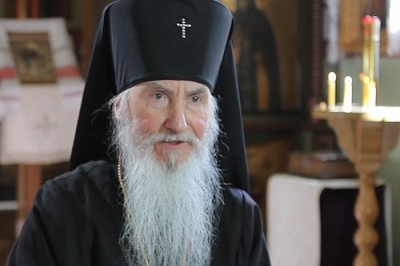
His Eminence Archbishop Mark of Berlin and Germany has a close spiritual connection with the Russian sites of Mt Athos. He first visited the Holy Mountain at the age of 25, having just begun his teaching career. A thrilling account of a visit to Mt Athos by a young man, a member of the group �Orthodox Work,� inspired his trip.
Wishing to see firsthand an entirely different and unknown world within the territory of modern Europe, which is what the monasteries of Mt Athos represent, the future bishop took it upon himself to make a pilgrimage there.
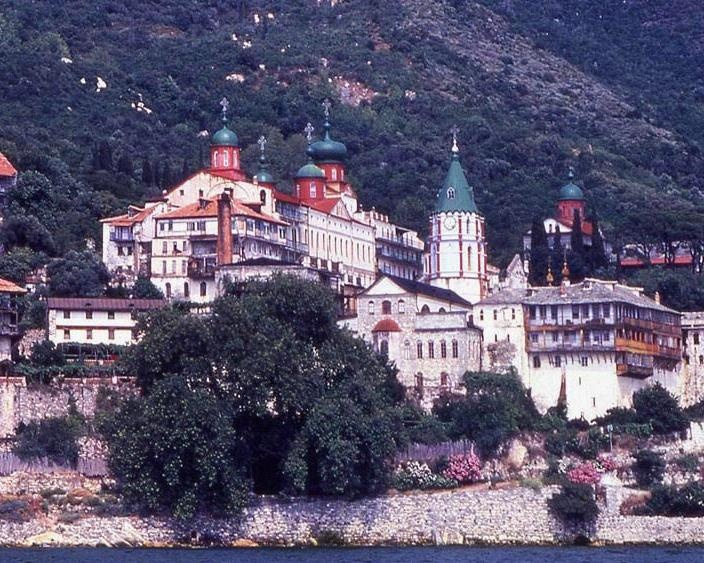
He sensed the prayer-infused life of Mt Athos. This first pilgrimage gradually became an annual event, and the future Vladyka Mark would sometimes go twice a year. He would spend a good deal of time there: two or two-and-a-half months at a time. He would split his time between St Panteleimon Monastery, St Elias Skete and Karoulia. At the time, St Elias Skete was under the jurisdiction of the Russian Orthodox Church Outside of Russia, and had no contact with St Panteleimon Monastery, which commemorated the Patriarch of Moscow and All Russia. Still, it was at the latter monastery that Vladyka Mark found his first spiritual father, Schema-Archimandrite Avel (Makedonov). There, Vladyka Mark made frequent confession, read on the kliros and actively participated in Russian monastic life.
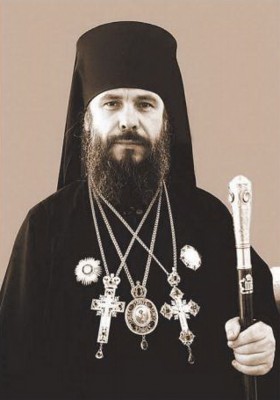
According to Vladyka Mark, he made his first confession to Fr Avel; with his blessing he began to read on the kliros and later was tonsured a monk. His close filial relationship with his spiritual guide continued even as a priest and later hierarch of the Russian Church Abroad. As he admits himself, it was Fr Avel�s influence that imparted his firm decision to help achieve the reestablishment of full brotherly communion within the Russian Orthodox Church.
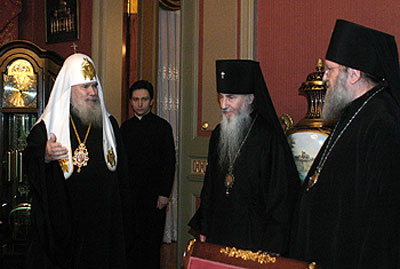
Noteworthy among Vladyka Mark�s recollections is the fact that during his visits there were still many elders who remember the �old days� when their teachers were the great ascetics, Ieronym, Macarius and Andrei.
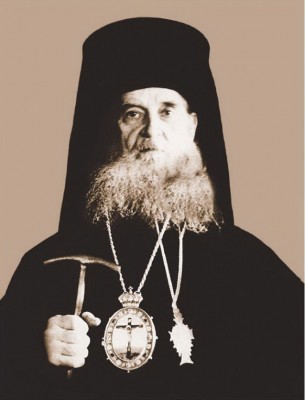
Schema-Archimandrite Ilian (Sorokin) was then the abbot of St Panteleimon Monastery. Many noticed the remarkable traits of this monk: he joined the monastery in 1905. In 1958, after the death of Abbot Justin, he was elected abbot and elevated to the rank of archimandrite. This is what the author Anatoly Darov wrote about him:
Archimandrite Ilian�s eyes are very calm, other times they are strict but tender. It is difficult to say how old he is, but asking him would be more difficult. There are such people in the world: it is easy to ask them for something, but hard to ask them something. A soft, delicate prohibition gleamed in his eyes. No, this was not the severe ascetic refusal of this world that one sees in Fr Mikhail [of the Monastery of St Andrey], not the child-like yet wise trust of Fr Nikolai [of St Elias Skete], this is a sorrowful, troubled, yet ingratiating spirituality� Fr Ilian exhausts himself with divine services. When he dies, you won�t find another abbot like this anywhere in the world.
In June of 1962, during the celebration of the 1000th anniversary of Mt Athos, he was awarded the Medal of St Vladimir by the Moscow Patriarchate for his service to the Church.
Another wonderful elder whom Vladyka Mark came to know was Hiero-Schemamonk Serafim (Tekza). Fr Serafim, born in the Carpathian Mountains in 1901, arrived to Mt Athos in 1925. According to Vladyka Mark, it was this elder who had the greatest effect on him in how he lived his daily life. This was a venerable hieromonk of the community, earning great respect among the monks for his spirituality and discernment. Fr Serafim headed the monastery�s apothecary, gathering medicinal plants from the woods of Mt Athos. He was always prepared to help his suffering brethren. Although old and feeble himself, he would sit at the bedside of an ailing brother for hours, praying to the Lord for his relief. The monks joked that his love-filled heart brought more benefit to the sick than the herbs he administered. On December 25, 1972, Patriarch Pimen awarded him an ornamented cross during his visit to Mt Athos.
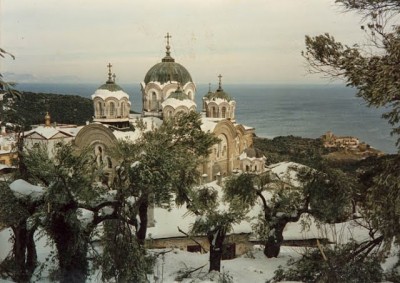
Vladyka Mark spent most of his time at St Elias Skete. At the time, it was headed by Hegumen Archimandrite Nikolai, who arrived in 1900 and never once left it. In 1952, after the death of Abbot John, he was elected the new abbot by the monks. He was forced to lead the skete during a period of its complete collapse, both spiritually and materially. A brief biography was composed by Darov which illustrates his relationship with the Moscow Patriarchate. Despite the resistance of many in the effort to reconcile with the Russian Church, he and other Russian residents of Mt Athos deep down hoped for the speedy restoration of relations with Moscow. �Poor Alexy [Patriarch of Moscow] could not come after all, and I feel sorry for him as a human being, for he was old and, they say, sick. Mt Athos would have helped him so much!� From another passage we see how close Fr Nikolai was with the heads of the other two Russian monastic communities, Fr Ilian and Fr Mikhail (Dmitriev): �Ilian, as well as Miklhail and I. We are all related, but we are all different!� Fr Nikolai died on April 17, 1973. He was the last Russian abbot of St Elias Skete. By the time of his death, there were only three monks remaining, so they did not bother to elect a new abbot.
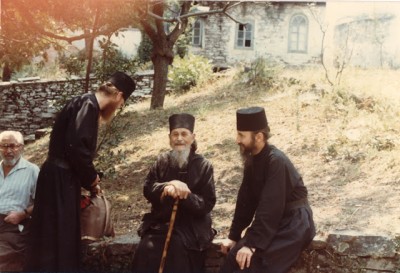
In Karoulia, which Vladyka Mark often visited, two Russian schema-monks lived, Fr Nikodim and Fr Seraphim, as well as the Serb Fr Stefan. They had been performing their ascetic labors there since 1917. He spent a great deal of time with them and received much spiritual wisdom, especially with regard to the Jesus Prayer.
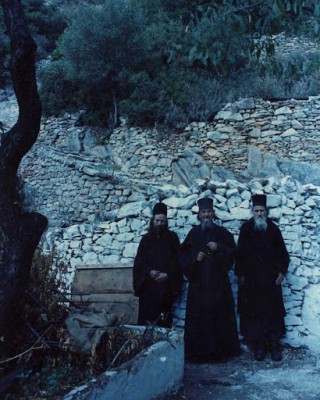
Vladyka Mark still thanks God for allowing him to befriend these elders and partake of the endless wellspring of Russian spiritual culture. Gradually, the notion grew strength that he should join St Elias Skete. He examined himself for 8 years, fasted like a monastic, arose at night and read the monastic rule.
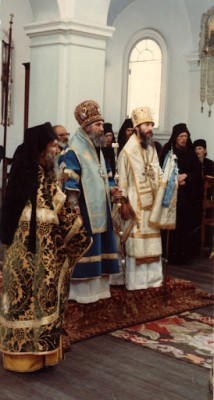
He measured his capabilities gradually. For him, the hope that he might one day come here for good brought him great joy. Unfortunately, it was not to be. Greece was under a military dictatorship at the time, and the �black colonels� would not allow the Russian monasteries of Mt Athos to grow out of a sense of nationalism. Gradually, the Russian monastic communities began to fade. St Andrew and St Elias Sketes transferred to the Greeks. St Panteleimon Monastery was almost lost, too. The Greeks from neighboring monasteries would visit to �stake out� the possibility of moving there.
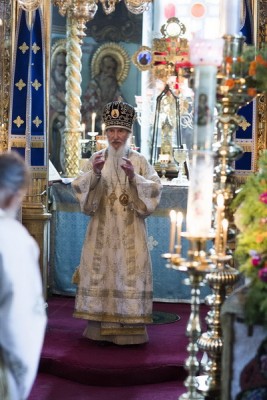
Vladyka Mark�s present visit to Mt Athos coincide with the celebration of the �Light-Painted� Icon of the Mother of God, wishing to venerate the miraculous image. Archbishop Mark led the solemn service, all-night vigil and Divine Liturgy. Afterwards, a procession of the cross was held to the very site where, in 1903, the icon of the Mother of God first appeared, where Vladyka Mark performed a meleben with the blessing of the waters at the local wellspring in the chapel of the �Light-Painted� Icon of the Most-Holy Mother of God.
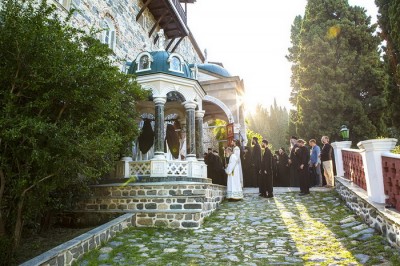
Vladyka also visited other churches of St Panteleimon Monastery and venerated their relics and icons. He entered Protection of the Mother of God Cathedral with special joy, for it was here that the liturgical life of the Russian monks of the 1970�s mostly took place when he visited as a young man.
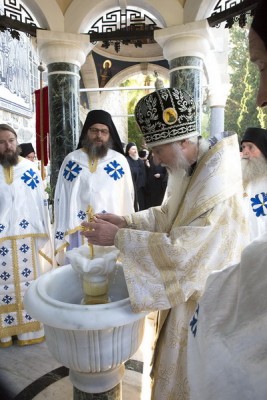
On Saturday, September 5, 2015, Vladyka Mark celebrated commemorative Divine Liturgy at the Church of SS Peter and Paul in the monastery�s cemetery. He prayed for the reposed monks of the monastery, many of whom he had known personally. Later that day, after giving his blessings, Vladyka Mark left the Holy Mountain.
Arseny Tarasov �Russian Athos�
afonit.info
|